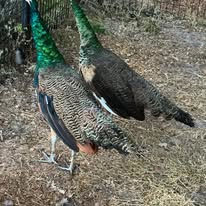
OUR ANIMALS
MEET THE RESIDENTS OF TWIN PINE
SUMMER CAMP & PRIVATE TOURS
At TPFECF, our animal residents represent a unique and diverse collection of rare and exotic species from around the world. Many are part of ongoing conservation breeding programs, scientific research initiatives, or serve as ambassadors in our educational outreach.
Each animal in our care receives specialized attention—including species-specific diets, species specific designed habitats, and enrichment that supports natural behaviors and overall well-being.
We are proud to share these incredible animals with the public through immersive learning opportunities. Private tours are currently available by appointment, offering an up-close experience with our animals and their caretakers. Summer camps and other seasonal programs will soon be offered to engage and inspire the next generation of wildlife stewards.
Come discover the wild world of TPFECF—where conservation meets connection.
Aardwolf
The Aardwolf is a rare insectivorous member if the hyena family native to the grassland and savannah ecosystems of Southern and Eastern Africa. The aardwolf prefers habitats where termites are abundant.

Asian Leopard Cats
Small, elusive wild cats native to Southeast Asia; known for their agility and role in conservation discussions surrounding the exotic pet trade.

Fishing Cats
Semi-aquatic felines that thrive in wetland habitats; they use their paws to catch fish and frogs with impressive precision.

Spotted Genet
A slender, nocturnal carnivore with striking spots and a long, ringed tail; known for their agility and curious nature.

Red Kangaroo & Wallabies
Gentle marsupials from Australia; these joeys are often featured in hands-on animal encounters and educational sessions.

Ostrich & Rhea
Large, flightless birds from Africa and South America, respectively; excellent examples of avian adaptations and behavior.

Sloths & Kinkajou
Arboreal mammals from Central and South America; ideal ambassadors for rainforest biodiversity and conservation.

African Wildcats
Ancestors of domestic cats; these small predators are an important part of African ecosystems and species education.

Coatimundi
Highly social, intelligent mammals related to raccoons, native to the Americas and popular for enrichment demonstrations.

Goats & Donkeys
Friendly domestic species that help visitors of all ages connect with animals in an approachable way.

Bat Eared Fox
The bat-eared fox is a small canid, being of comparable size to the closely related cape fox and common raccoon dog and is found on the African savanna. It is named for its large ears, which have a role in thermoregulation. is a small canid, being of comparable size to the closely related cape fox and common raccoon dog.

Reptiles
Our facility also cares for various reptiles such as ball pythons, geckos, and more

Sloths
Sloths are noted for their slowness of movement and spend most of their lives hanging upside down in the trees of the tropical rainforests of South America and Central America.

Capybara (COMING SOON)
The capybara is the largest living rodent, native to South America. Its close relatives include guinea pigs and rock cavies, and it is more distantly related to the agouti, the chinchilla, and the nutria.

African Serval
The serval is a wild small cat native to Africa. It is widespread in sub-Saharan countries, where it inhabits grasslands, wetlands, moorlands and bamboo thickets. Across its range, it occurs in protected areas, and hunting it is either prohibited or regulated in range countries.

Lemurs
We house red ruffed and black & white ruffed Lemurs. They are endemic to the island of Madagascar. Most existing lemurs are small, have a pointed snout, large eyes, and a long tail. They chiefly live in trees and are active at night. Lemurs share resemblance with other primates, but evolved independently from monkeys and apes. Due to Madagascar's highly seasonal climate, lemur evolution has produced a level of species diversity rivaling that of any other primate group.

Ducks & Chickens
At TPFECF, we take great pride in caring for ducks and chickens too, ensuring they have a safe and nurturing environment. Our dedicated team provides them with nutritious and plenty of space to roam and explore.

Sulcata Tortoise
The Sulcata tortoise is one of largest tortoise species, renowned for its impressive size and distinctive spiky shell. Native to the grasslands and savannas of Africa, these gentle giants can live for over 50 years.

And Many More...
At Twin Pine Farm & Exotics Conservation Foundation, we take pride in our conservation efforts to many different species of animals. Contact us today for more information about our animals and how you can help our cause.
















